RSJ = Rolled Steel Joist |
|
BSUB = British Standard Universal Beam
|
|
BSUC = British Standard Universal Column
|
|
RSC = Rolled Steel channel |
|
BSEA = British Standard Equal Angle
|
|
BSUA = British Standard Unequal Angle |
|
RST = Rolled Steel Tee |
|
Zed Beams (‘Z’ Channel) |
|
Rolled Hollow Section
|
|
Circular (Round) Hollow Section
|
A ‘back mark’ is the distance from the heel of an angle or channel section to the centre of a hole in a flange.

Figure 1 - Back Mark
A ‘cross centre’ is the distance between two holes in a flange of a Universal column, beam, rolled steel joist or Tee section.
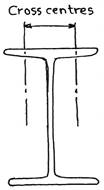
Figure 2 - Cross Centre 1

Figure 3 - Cross Centre 2
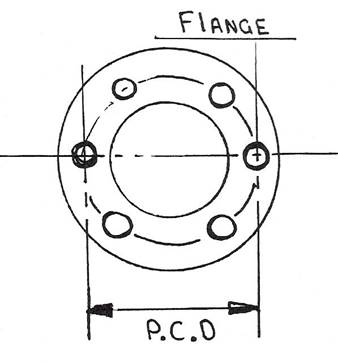
Figure 4 - Pitch Circle Diameter

Figure 5 - Splice Plate
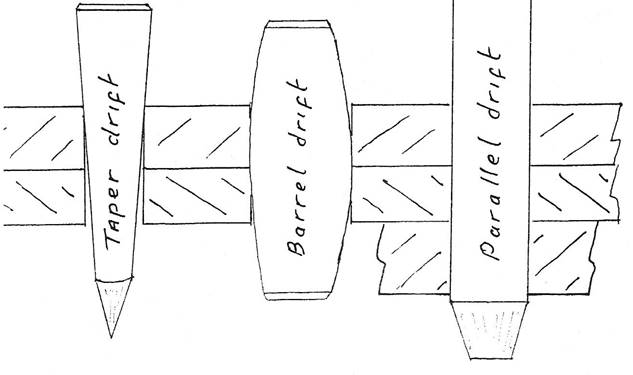
Figure 6 - Drifts
Taper Drift: used for ‘fairing’ or aligning holes. The plates move together to the correct position as the drift is hammered into the holes.
Barrel Drift: used for ‘fairing’ or aligning holes in confined spaces. The drift is hammered until it passes through the holes.
Parallel Drift: made approximately 0.75mm less than the size of the hole, used to ‘fair’ or align solid drilled work. The work being reassembled after separating for cleaning - de-burring etc.
A portal frame is a type of arch construction in which the roof member, whether a horizontal beam or pitched rafters is joined rigidly at the eaves to the stanchion to form a continuous plane frame. The pitched roof portal frame has the greater advantage of providing clear working space from floor to rafter level unobstructed by ties or bracing members. Portal frames can be of solid or open web construction.
The portal frame depicted in Figure 7 is one suitable for spans up to about 18m with height to eaves of about 5m arranged at centres up to 4.5m. The site joint at the apex would be unnecessary for spans less than about 12m.
The base detail is that normally adopted as pinned or hinged for such portals.
At site the frame is assembled on the ground, using high strength friction grip bolts, before erection.
Larger portal frames may require strengthening at eaves and ridge and this is usually achieved by haunching and deepening of the section respectively.

Figure 7 - Portal Frames
Since hot rolled mild steel sections were first produced in 1873 lattice steel roof trusses have been the most commonly used structures for medium and long span roofs. They comprise triangular lattice frames of light steel sections riveted, bolted or welded together to support light section steel purlins, which in turn support the roof and roof covering. These trusses are spaced at from 3M to 7.5M apart supported on steel columns or loadbearing brick walls. Figure 8 is an illustration of the skeleton frame of a typical symmetrical pitch lattice steel roof. This type of roof framing is the cheapest available for spans of up to 15M.
The pitch is designed, primarily, to suit standard corrugated asbestos cement sheets, which are bolted to and supported by the steel purlins fixed to the rafters of the lattice steel trusses. The pitch of a roof is determined by the type of roof covering used, a pitch of 22%°, 25°, 30° degrees being common for asbestos cement sheets.
The spacing of the purlins is determined by the maximum centres at which the roof covering can safely be supported, which in turn is determined by the depth and number of the corrugations of the sheet roof coverings. The spacing of the purlins determines the arrangement of the members of the lattice inside each truss. Common practice is to provide a strut that is a vertical or near vertical member, under every other purlin along the length of the rafters of the truss, struts being connected by tie members to form a rigid triangular frame. Figure 9 illustrated some typical arrangements of the members of lattice steel trusses.

Figure 8 - Roof Truss
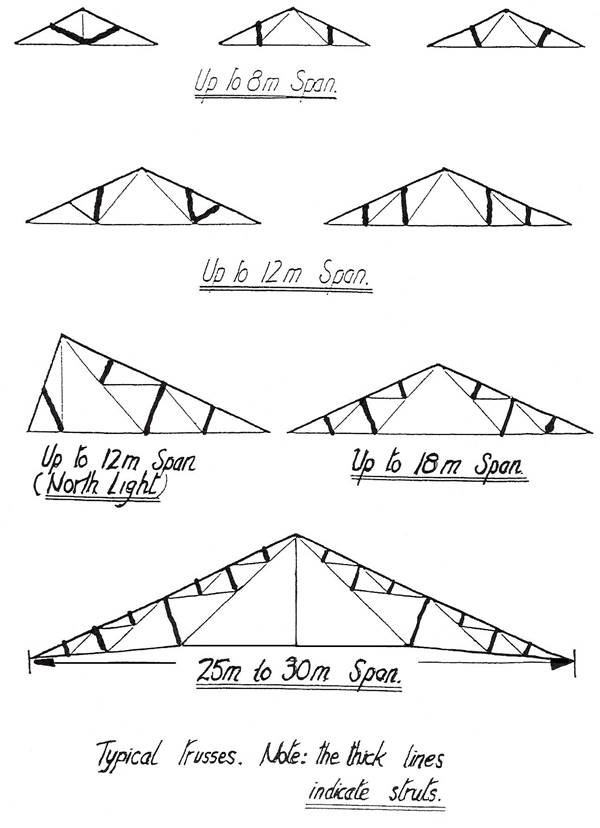
Figure 9 - Typical Trusses
Lattice girders, also sometimes called trusses, are plain frames of open web construction, usually having parallel chords or booms when used for roofs, and with internal web bracing members. They are extremely useful in long span construction in which their small depth/span ratio, generally from about 1/10 to 1/14, gives them a distinct advantage over roof trusses.
There are two main types of lattice girder, the N type shown in Figure 10 and the Warren type shown in Figure 10. It will be seen that in the case of the N girder the diagonal bracing members are arranged so that they act as ties. (If reversed they would become struts and the shorter, vertical members would be ties).
As with roof trusses, the framing of a lattice girder should be triangulated, taking into account the span and the spacings of the applied loads. That is to say, the booms are divided into panels of equal length and, as far as possible the panel points are arranged to coincide with the applied loads. This means that in the case of a lattice girder supporting roof trusses, the panel lengths would be such that the trusses connect at panel points.
If loading unavoidably occurs between panel points secondary framing can be introduced to prevent local bending in the boom members (Figure 10).
Where it is essential to omit diagonal members, the Vierendeel girder can be used. In this type of frame the internal members are all vertical and the joints are made rigid (Figure 10).
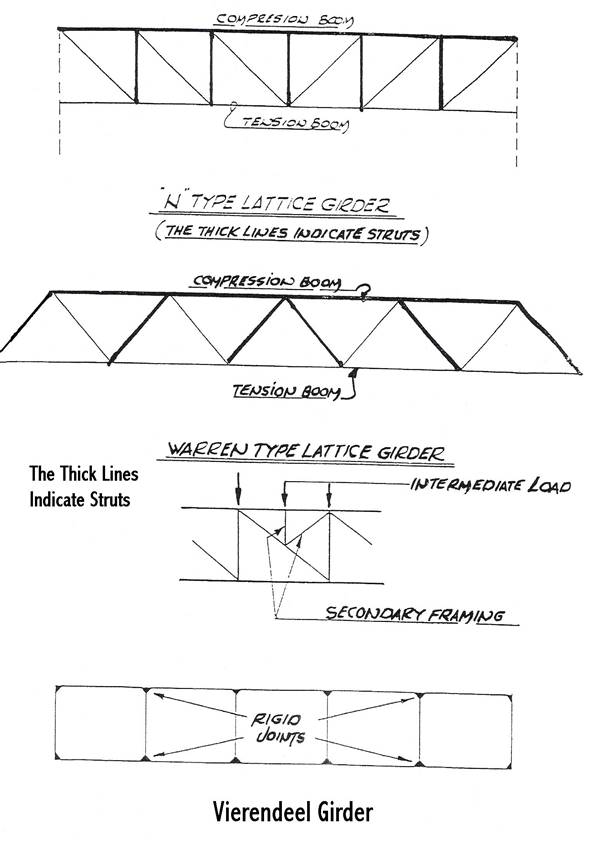
Figure 10 - Lattice Girders
This open web beam section is made by cutting the web of a hot rolled joist along a castellated line. The two halves so produced are then welded together to form the section illustrated in Figure 11.
The castellated beam is one and a half times the depth of the member from which it was cut, and therefore suffers less deflection under load. This section is economical for lightly loaded floors and the openings in the web are convenient for electrical and heating services.

Figure 11 - Original and Castella Beams
When referring to beams, columns, joists and channels the depth: overall distance from flange to flange is given first, followed by the breadth: width of the flange, followed by the mass per metre and finally the length required.
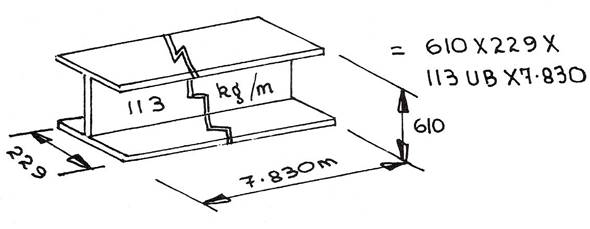
Figure 12 - Serial Size - Actual Size
Although the serial sizes are always referred to on drawings, the actual size of beams, columns etc. can vary considerably. BS41 gives dimensions for serial sizes of sections with mass per metre/actual depth and breadth/ and thickness of web and flange.
It will be seen that up to seven variations of a serial size is rolled and that the dimensions inside the flanges are constant, while the thickness of the web and flanges vary hence the variation in serial size and actual size.
Source: http://local.ecollege.ie/Content/APPRENTICE/liu/metalfab_notes/module6/Structural%20Drawing_M6_U12.doc
Web site to visit: http://local.ecollege.ie/
Author of the text: indicated on the source document of the above text
If you are the author of the text above and you not agree to share your knowledge for teaching, research, scholarship (for fair use as indicated in the United States copyrigh low) please send us an e-mail and we will remove your text quickly. Fair use is a limitation and exception to the exclusive right granted by copyright law to the author of a creative work. In United States copyright law, fair use is a doctrine that permits limited use of copyrighted material without acquiring permission from the rights holders. Examples of fair use include commentary, search engines, criticism, news reporting, research, teaching, library archiving and scholarship. It provides for the legal, unlicensed citation or incorporation of copyrighted material in another author's work under a four-factor balancing test. (source: http://en.wikipedia.org/wiki/Fair_use)
The information of medicine and health contained in the site are of a general nature and purpose which is purely informative and for this reason may not replace in any case, the council of a doctor or a qualified entity legally to the profession.
The texts are the property of their respective authors and we thank them for giving us the opportunity to share for free to students, teachers and users of the Web their texts will used only for illustrative educational and scientific purposes only.
All the information in our site are given for nonprofit educational purposes